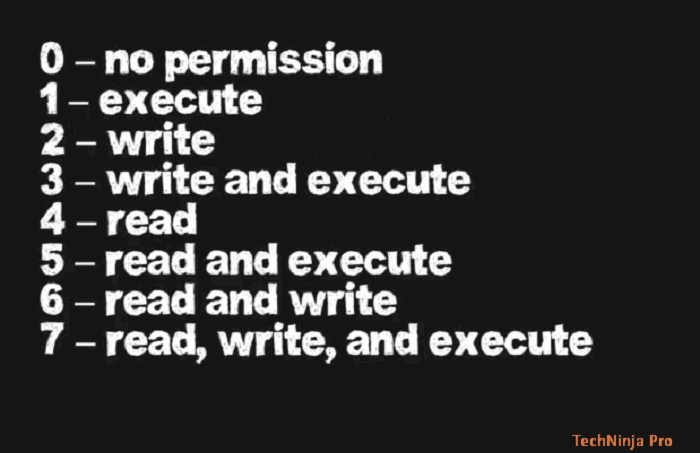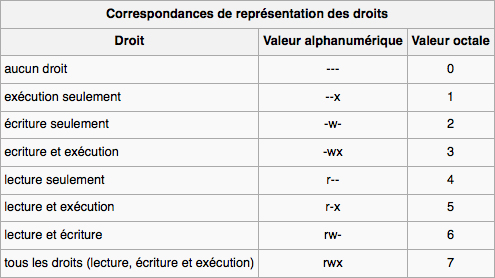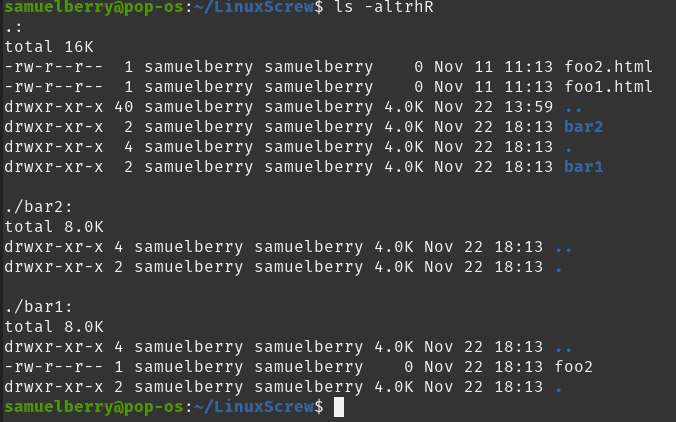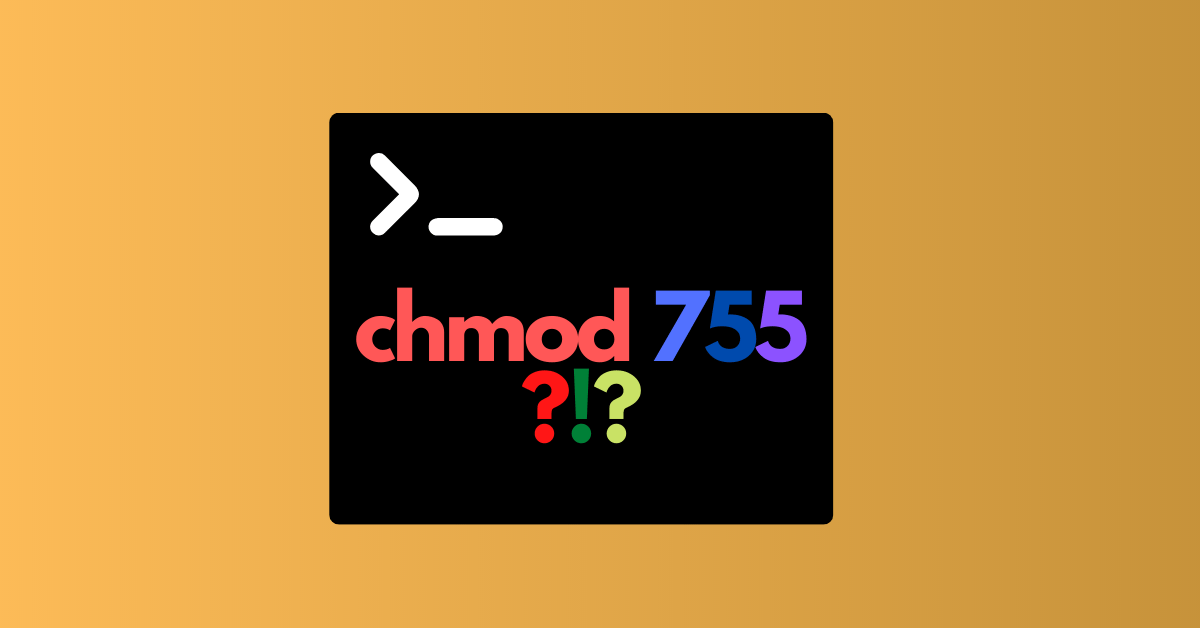Chmod 755 R /opt/lampp/htdocs will recursively set the permissions There's no way to set the permissions for files automatically in only this directory that are created after you set the permissions, but you could change your systemwide default file permissions with by setting umask 022 Linux Solution 7 chmod 755 $(find /path/to/base/dir type d) chmod 644 $(findHow to change your file to 755 or rwxrxrx using chmod Chmod is a well known command line utility, that's used to manage file permissions on MacOS, Linux and other Unix like operating systems While there are multiple ways to use chmod, on this site, we have chosen to focus exclusively on using chmod with Octal Notation $ chmod 755 R directory_name $ chmod 755 R /home/linuxtechi/data Example 3) Assign permissions using text notation Another way of assigning permissions is by using the text notation In this method, the chmod command takes flags or symbols which represent the owner, group, others or all users ( u, g , and o) in the syntax
Command Line The Favored Operating System Flavor In
How to chmod 755
How to chmod 755- Unix commandline tools to change the access permissions Unix provides a number of commandline tools to change the access permissions Note that only the owner of the file can change the access permissions 1 chmod change file access permissions description This command is used to change the file permissions These permissions are readChmod R 755 /home/Data/task1;




Chmod 777 Or 755 Learn To Use Chmod Command With Examples
Chmod(0755, $_) chmod(0644, $_)' You'd have to use the numeric uid, gid, and mode, but think about this this does not fork at all (beyond the one find and the one perl)Chmod 777 or 755? chmod Change Mode The two most commonly used 'modes' you'll come across in Android are '777' and '755' These numerical pemissions have different meanings, of course This can be a little confusing, so I hope this explains it in a simple to understand way As you can see, there are three numbers in the following example;
What is chmod ?Chmod 755 Chmod 755 ( chmod arwx,gw,ow) sets permissions so that, (U)ser / owner can read, can write and can execute (G)roup can read, can't write and can execute (O)thers can read, can't write and can execute Owner Rights (u) find /main_directory/ exec chmod 755 {} \;
$ chmod R 755 directoryname/ 7 Change execute permission only on the directories (files are not affected) On a particular directory if you have multiple subdirectories and files, the following command will assign execute permission only to all the subdirectories in the current directory (not the files in the current directory) $ chmod uX * Note If the files hasWhat is chmod 755?Chmod 777 Everything for everyone This command will give read, write and execute permission to the owner, group and public If you want to change the mode to 777, you can use the command like this chmod 777 filename How do you change permissions in Unix?




How To Use Chmod And Chown Command In Linux




Chmod Wikipedia
In the first command, for the 'others' clearly I haven't given any ownership to the files and in the second command I am giving read and execute permission to others (chmod 755) So what will exactly happen now? Issue the following commands chmod 755 /mnt find /mnt type d perm 644 >/mnt/badpermissions find /mnt type d exec chmod 755 {} The first find command saves a record of directories with bad permissions into a file The purpose is to see where permissions have been modified The second find command changes all directories to be publicly accessible YouThis video covers the chmod command in depth and everything you want to know about change modeBoth Octal and symbolic modes




Chmod Command Examples Of Use Chmod Command Examples Of Using The Resolution Command For The Linux 777 Folder




Linux Chmod Command Linuxfordevices
755 signifie un accès en lecture et en exécution pour tout le monde et également un accès en écriture pour le propriétaire du fichier Lorsque vous exécutez la commande chmod 755 filename, vous autorisez tout le monde à lire et à exécuter le fichier, le propriétaire est également autorisé à écrire dans le fichier chmod is Linux command used to change file permissions chmod changes user, group and other read, write and execute permission chmod 755 is popular use case for chmod chmod 755 is generally used to make most of the operations without problem because it provides ease for system administrators while running applications chmod 755 Directory permissions can be adjusted using the same chmod commands as were previously outlined for modifying file permissions The following example changes permissions on a directory to 755 (owner has read, write and execute permissions, while users with the group or any other user have read and execute permissions) chmod 755 /exampledirectory/



Command Line The Favored Operating System Flavor In




Chmod 777 Or 755 Learn To Use Chmod Command With Examples
What is chmod 777 command?It is also used to change special mode flags The request is filtered by the umask The name is an abbreviation of change mode History A chmod command first appeared in AT&T Unix version 1 As systems grew in number and Chmod 4755 Chmod 4755 (chmod arwx gw ow ugs t gs t) sets permissions so that (U) ser / owner can read can write and can execute (G) roup canGet Started with Red Hat Insights;




Modify File Permissions With Chmod Linode



Chmod 755 Command What Does It Do Codefather
To change file and directory permissions, use the command chmod 755 MyDir rxwrxrx Unix/Linux chmod command examples Summary I hope these Unix/Linux chmod command examples have been helpful There's much more to say about the chmod command, but I hope all of these examples are enough to help explain most things you'll see on a daily basis chmod command is one of the useful commands in user and file management (especially script files) Here we are going to explain to you chmod 775, 755 & File permissions File Permissions in Linux using Chmod




Linux Chmod Command Javatpoint




Using Chmod X Command On Linux And Unix With Examples Systemconf
Chmod 775 (chmod arwx,ow) définit les autorisations de sorte que (U)ser/owner puisse lire, écrire et exécuter (G) groupe peut lire, écrire et exécuter ( D'autres peuvent lire, ne peuvent pas écrire et peuvent exécuter 1 Qu'estce que l'autorisation 775 Unix ? People often forget that perl has equivalents for many of these basic shell commands Here's one way I'd do this (tested) find perl lne 'chown 1001,1001, $_; Chmod is a command of linux (unix like systems) that can be used to modify the file permissions it changes group, user, and others to execute, write, and read permission this chmod 755 linux command is an essential use case to chmod generally, this command is applied to make various operations without any kind of difficulty because it I'll also explain some the popular terms like chmod




Permissions Reverting From Executing Chmod By Mistake Ask Ubuntu




Changing File Permissions Wordpress Org
755 signifie un accès en lecture et en exécution pour tout le monde et également un accès en écriture pour le propriétaire du fichier Lorsque vous exécutez la commande chmod 755 filename, vous autorisez tout le monde à lire et à exécuter le fichier, le propriétaire est également autorisé à écrire dans le fichier Others might want to read the contents but not modify them Of course, you can change this setting with the chmod command, which is the focus of this article More Linux resources Advanced Linux Commands Cheat Sheet for Developers;Chmod calculator generates command in number format for file and directory permissions in Unix and Linux If you are working on Unix, Linux server then permissions are a very important and difficult task Our chmod calculator generates file permissions for owner, group, and the public in number (744) and symbolic (rwxrr) notation formats




Unix Commands Changing Permissions Dreamhost Knowledge Base
/i7guGwCYcn-34e068e148ae4e918b29c86cd2d5740e.png)



Configuring Unix Linux File And Directory Access Rights
We use chmod command to change the permissions of a file in Unix In this command we can pass the file permissions in the form of a threedigit number In this number 755, first digit 7 is the permissions given to owner, second digit 5 is the permissions of group and third digit 5 is the permissions of all othersIs there anyway to compact the follow UNIX command chmod 755 scriptAksh chmod 755 scriptBksh chmod 755 scriptCksh chmod 755 scriptDksh The above command makes every KornShell (ksh) script executable, so the compacted command will be shorter in length and still make every ksh script executable shell commandline scripting chmod ShareLearn to use chmod Suppose that user `joe' wants to copy the file `progf' from user `fred' At the Unix prompt, Fred should type chmod gox ~ This command changes the mode of Fred's home directory represented by the ~, giving permission to all users to get to files in that directory Unix File Permissions In previous chapter we have discussed different file commands




Unix Commands Chmod Linux Commands Mac Commands Faun




Unix Linux Command Reference
For example, to change the permissions of all files and subdirectories under the /var/www directory to 755 you would use chmod R 755 /var/www Operating on Symbolic Links # Symbolic links always have 777 permissions By default, when changing symlink's permissions, chmod will change the permissions on the file the link is pointing to chmod 755 symlinkDownload Now Basic Linux Commands Cheat Sheet;Chmod command is used in two ways 1 Using octal value & position Sets the permission for owner, group and others with octal values , 4 for read , 2 for write , 1 for




Chmod Command In Ubuntu 04 How It Works




Chmod 777 In Terminal The Command To Make All Changes Affect Every File And Folder Ask Ubuntu
If I haven't given any ownership to 'others', what's the point of giving file permission ofChmod stands for change mode, which changes the file or directory mode bits To put it simply, use chmod command to change the file or directory permissions Following is a sample of ls l command output In this, the 9 characters from 2nd to 10th position represents the permissions for the 3 types of usersChmod is a command of Linux (Unixlike systems) that can be used to modify the file permissions It changes group, user, and others to execute, write, and read permissionThis chmod 755 Linux command is an essential use case to chmod Generally, this command is applied to make various operations without any kind of difficulty because it facilitates ease for many




Using Find Command In Unix And Linux Systems Shirishweb




Chmod 755 Command What Does It Do Codefather
Chmod (change mode) is one of the most frequently used commands in unix or linux operating system The chmod command is used to change the file or directory access permissions To know about the access permissions of a file or directory, use the ls l command as shown below $ ls l samplesh rwxrwr 1 matt deploy 94 Oct 4 0312 sampleshIf the find command returns a long list, this will take a lot of time I know that I can use the stat command to check the Octal file level permission of each component and then use ifelse to toggle the file permission, but is there any single line approach using find and xargs to first check what permission the file/directory has, In Unixlike operating systems, the chmod command is used to change the access mode of a file The name is an abbreviation of change mode Syntax chmod referenceoperatormode file The references are used to distinguish the users to whom the permissions apply ie they are list of letters that specifies whom to give permissions The




Chmod 644 755 777 What S The Difference Linuxpip



1
Permisos en Linux chmod 777, chmod 644, chmod 755, chmod 700, chmod 666 Esta opción permite que todos los usuarios puedan leer y escribir en un archivo Con este permiso el propietario del archivo puede leer, escribir y ejecutar en el archivo mientras que los demás leer y escribir en el archivo mas no ejecutarUse the octal CHMOD Command chmod R 655 folder_name OR use the symbolic CHMOD Command chmod R arwx,ux,gw,ow folder_name Chmod Permissions for chmod 655Qu'estce que la commande chmod 775 sous Linux ?



Using Terminal To Set File Permissions Amsys




Brute Logic Sur Twitter Unix Linux Command Reference By Makeuseof Http T Co Pqmv6mfigd
Chmod 754 (chmod arwx,gw,owx) sets permissions so that, (U)ser / owner can read, can write and can execute (G)roup can read, can't write and canChmod ( Change Mode ) is a command line utility in Unix , Linux and other Unix like systems to change the read, write, execute permissions of a file for owner , group and others How to use chmod?Chmod 775 (chmod arwx,ow) sets permissions so that, (U)ser / owner can read, can write and can execute (G)roup can read, can write and can execute (O)thers can read, can't write and can execute (G)roup can read, can write and can execute



Using Chmod X Command On Linux And Unix With Examples Systemconf




Change File And Folder Permission On Ubuntu Chmod Chown Command In Linux Youtube
Chmod is Linux command used to change file permissions chmod changes user, group and other read, write and execute permission chmod 755 is popular use case for chmod chmod 755 is In Unix and Unixlike operating systems, chmod is the command and system call which is used to change the access permissions of file system objects (files and directories)Ls l /home/Data/task1 Output drwxrxrx umask command in Unix New files are created with a default set of permissions Specifically, a new file's permissions may be restricted in a specific way by applying a permissions "mask" called the umask The umask command is used to set this mask, or to show you its current value




File Permissions In Linux Unix Vk9 Security
:max_bytes(150000):strip_icc()/create-directories-linux-mkdir-command-3991847-55ea75a52f7842a2af0fdfe0b7470270.gif)



How To Use The Chmod Command In Linux




What Is Chmod 777 How To Change File Permissions For Linux




Linux Mac Os Unix File Permissions And User Classes The Developer S Tidbits




Chmod Command In Linux Operators Used In Chmod Command In Linux




What Is The Meaning Of Chmod 755 And How To Execute And Verify It




Linux Chmod Command Dracula Servers Tutorials



Best Linux Chmod Command With Examples




Linux Cheat Sheet



2




Chmod 755 775 Recursive Ssh Permissions Chmod 775 Vs 777




Chmod Recursive




File Permissions In Linux Unix Vk9 Security




Command Line For Windows An Ok Ssh Program Is Putty Ppt Download
/GettyImages-1021092796-ea8c63ee76f84bd5bf98c4222337fbb4.jpg)



How To Use The Chmod Command In Linux




Linux Unix Permissions And Chmod Youtube




Understanding File Permissions What Does Chmod 777 Mean Make Tech Easier




Bif703 File Permissions Ppt Download




9 Quick Chmod Command Examples In Linux




Unix Permissions




What Is Chmod 777 How To Change File Permissions For Linux




A Unix And Linux Permissions Primer Daniel Miessler




Chmod Command In Linux With Examples Geeksforgeeks



Linux Command Line Basics Part 4 I Have A Pc I Have A Pc




Gandalf Linux Debian Command Lines Unix Ubuntu Linux Mint 19x1080 Uhd Wallpapers Walldump Free Hd And Uhd Wallpapers




Csci 330 The Unix System The File System




What Is The Meaning Of Chmod 755 And How To Execute And Verify It




Basic Linux Commands With Examples Ppt



Chmod 777 Or 755 Learn To Use Chmod Command With Examples




Linux Chmod Command Linuxfordevices




Linux Commands Chmod




Modification Chmod Gestion Des Droits Des Fichiers Et Dossiers




Chmod 644 755 777 What S The Difference Linuxpip




Chmod Commande Chmod Linux Unix Forums Cnet France




Linux Chmod Example




Explain Chmod Command In Unix




Understanding Linux Permissions And Chmod Usage



How To Chmod Files Only On Linux




How To Reset Website File Permissions From Command Line Vi Wickam Online Expert



Chmod Command In Unix Learn Unix Online Fresh2refresh Com




How To Change Permissions In Linux




Unix File Permissions Computer Science




The Chmod Command And Linux File Permissions Explained




What Does 755 Permissions Mean In Unix



Using Chmod X Command On Linux And Unix With Examples Systemconf




How To Recursively Change The File S Permissions In Linux Linuxize




Chmod Recursive Change Permissions Recursively On Files Folders



1



3




Linux Command Lines Unix Ubuntu Hd Wallpapers Desktop And Mobile Images Photos




Unix Test Pdf Computer File Unix Software




Linux Chmod Recursive How To Change File Permissions Recursively




Chmod 777 Or 755 Learn To Use Chmod Command With Examples



1




Basic Linux Commands Linux




Mysql Basics In Pictures Edit A Script




How To Give Permissions In Mac Os X Info Window Chmod Teksaviors




Chmod 755




Linux Unix Permissions And Attributes Linuxsecrets




How To Use Chmod Change Mode Repair Your Pc Now



Linux Command Line Basics Part 4 I Have A Pc I Have A Pc



Common Bash Commands




Command Line What Is The Difference Between Chmod X And Chmod 755 Ask Ubuntu




Understanding File Permissions




Chmod 755 Command What Does It Do By Claudio Sabato Medium




What Is The Meaning Of Chmod 755 And How To Execute And Verify It



Using Chmod X Command On Linux And Unix With Examples Systemconf




Explained How To Use Chmod Command Complete Guide Youtube



What Does Chmod 755 Do Quora




Javarevisited 10 Examples Of Chmod Command In Unix Linux




Chmod Umask Stat Fileperms And File Permissions




Chmod Command In Linux With Examples Geeksforgeeks




Linux Chmod Command Help And Examples



Chmod X Windows Nativeyellow




Chmod Wiki Ask Ubuntu




Chmod Command In Linux File Permissions Linuxize




How To Change File Permissions Recursively With Chmod In Linux




Ppt Agenda Powerpoint Presentation Free Download Id



0 件のコメント:
コメントを投稿